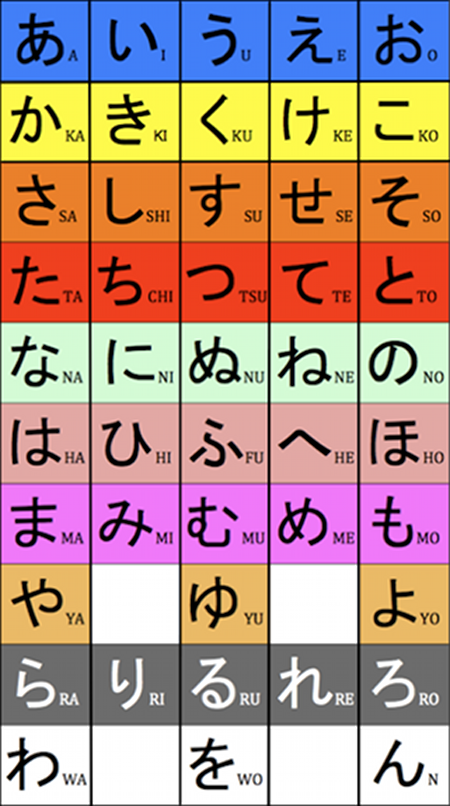Post by dollmaker on Sept 19, 2014 4:51:33 GMT
Learning Japanese is a great way to access alot of mangas that you might not have the chance to read in other languages. It also let you read the latest chapters really fast and you can then help us out with translating!
So, what to do to start learning Japanese? This is assuming you already have a basic grasp of Japanese words through watching animes, Jdramas, whatever. So now, you want to learn how to read instead. As a non native speaker trying to learn, Japanese language was not that difficult for me as my mother tongue is in Korean and our languages share similarities in terms of grammar, gendered language, hierachy based language, formal/informal speeches. Well, all these will come later as a whole new world ahead after we learn the basics but, as a beginner, what I did was first (and would recommend is) to learn how to read the alphabets. The Japanese writing system is divided into 3 systems
A) KATAKANA - Mostly used for foreign words, animals, etc, places, foreign names
B) HIRAGANA - Mostly used for japanese words
C) KANJI (with FURIGANA)- chinese characters and where furigana are little hiragana written beside kanji to reflect how that kanji is pronounced phonetically.
I would recommend starting with learning and memorising KATAKANA. Katakana itself is separated into parts. So, by memorising and understanding it by parts, was a easier method for me to learn than just trying to memorise the whole Katakana chart at one go (it will just confuse you).

Above is a basic KATAKANA chart. What I meant by basic is that these are the basic form before we add on the diacritics, combinations and diacritics with combinations in the next few parts. What what you say? Diacritics? Combinations?
KATAKANA with DIACRITICS (DAKUTEN)
Diacritics are signs such as accents, which when written above or below a letter indicates a difference in pronounciation from the same letter when unmarked or differently marked. These diacritics are in 2 forms, the "Dakuten" and the "Handakuten". Refer to the image below.

BELOW: KATAKANA WITH DAKUTEN (DIACRITICS)

Note: Handakuten (the small circle) changes the sounds to a "P" sounds when on.
KATAKANA WITH COMBINATIONS
Katakana with combinations (YOON)
The Yoon system uses smaller than usual versions of the "y" kana (ya,yu,yo) to make a contracted word. Below are the KATAKANA with YOON on.

Note: noticed above image, the last 5 rows are what we called Katakana with Diacritics and Combinations (It has both the yoon and dakuten/handakuten together)
TIP:The easiest way to remember how Yōon characters change is to follow this simple rule: If an ‘i’ kana is pronounced with two letters, then drop the second letter only, and add the full ‘y’ kana sound. If an ‘i’ kana is pronounced with three letters, then drop the third letter only, and drop the ‘y’ sound from the ‘y’ kana.
So, there you go! That is Katakana for you ^^
Next time, The Hiragana
So, what to do to start learning Japanese? This is assuming you already have a basic grasp of Japanese words through watching animes, Jdramas, whatever. So now, you want to learn how to read instead. As a non native speaker trying to learn, Japanese language was not that difficult for me as my mother tongue is in Korean and our languages share similarities in terms of grammar, gendered language, hierachy based language, formal/informal speeches. Well, all these will come later as a whole new world ahead after we learn the basics but, as a beginner, what I did was first (and would recommend is) to learn how to read the alphabets. The Japanese writing system is divided into 3 systems
A) KATAKANA - Mostly used for foreign words, animals, etc, places, foreign names
B) HIRAGANA - Mostly used for japanese words
C) KANJI (with FURIGANA)- chinese characters and where furigana are little hiragana written beside kanji to reflect how that kanji is pronounced phonetically.
I would recommend starting with learning and memorising KATAKANA. Katakana itself is separated into parts. So, by memorising and understanding it by parts, was a easier method for me to learn than just trying to memorise the whole Katakana chart at one go (it will just confuse you).

Above is a basic KATAKANA chart. What I meant by basic is that these are the basic form before we add on the diacritics, combinations and diacritics with combinations in the next few parts. What what you say? Diacritics? Combinations?
KATAKANA with DIACRITICS (DAKUTEN)
Diacritics are signs such as accents, which when written above or below a letter indicates a difference in pronounciation from the same letter when unmarked or differently marked. These diacritics are in 2 forms, the "Dakuten" and the "Handakuten". Refer to the image below.

BELOW: KATAKANA WITH DAKUTEN (DIACRITICS)

Note: Handakuten (the small circle) changes the sounds to a "P" sounds when on.
KATAKANA WITH COMBINATIONS
Katakana with combinations (YOON)
The Yoon system uses smaller than usual versions of the "y" kana (ya,yu,yo) to make a contracted word. Below are the KATAKANA with YOON on.

Note: noticed above image, the last 5 rows are what we called Katakana with Diacritics and Combinations (It has both the yoon and dakuten/handakuten together)
TIP:The easiest way to remember how Yōon characters change is to follow this simple rule: If an ‘i’ kana is pronounced with two letters, then drop the second letter only, and add the full ‘y’ kana sound. If an ‘i’ kana is pronounced with three letters, then drop the third letter only, and drop the ‘y’ sound from the ‘y’ kana.
So, there you go! That is Katakana for you ^^
Next time, The Hiragana





